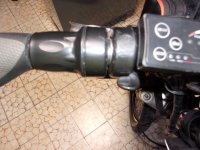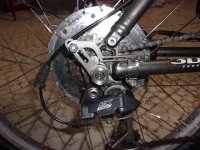thunderstorm80
1 kW
- Joined
- Mar 29, 2016
- Messages
- 383
Hi everybody,
After all my questions here during the recent months, I am happy to show you my built E-bike.
The bicycle is a Mongoose otero elite full suspension MTB, with 26inch wheels.
I bought it used specially for this project, because nowadays 26inch MTB's are very cheap.
It has 24gears, the rear shock absorber is SR Suntour "Epicon" which is air inflated (200PSI max), and the front is a simple elastomer SR Suntour:
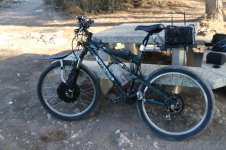
There are two motors.
Front 9C+ 2706:
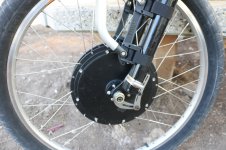
You can see how I used the disc-brake boss for a snug fit of the torque arm in the following close up image:
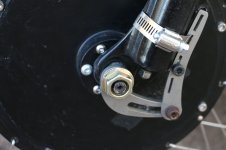
Although the bike originally came with hydraulic disc brakes, I changed the front one to V-brake for two reasons:
1. The 2706 has compatibility issues with discs
2. I couldn't find E-brake lever for hydraulic brakes...
The rear motor is the new cassette version of the 250rpm ezee, called ezee250rc on Grin website:
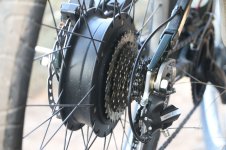
That modern motor fits the disc rotor perfectly as it was just a standard hub. The 8 speed cassette has been transferred as well - It's so nice to have the modern cassette-freewheel, instead of the older threads.
One downside (but also a plus-side), is that the ezee comes with a high quality cassette-freewheel, and since it has like 100 pawls it makes a much stronger buzz than the cheaper freewheels.
I used a front torque arm for the ezee, as you can see in the pic:
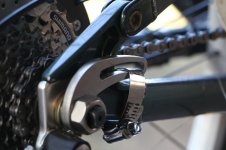
Why?
The V4 rear one couldn't be made to fit, since the frame has pivoting points very close to the dropout.
I mounted the torque arm, and using a hose-clamp applied a moderate forward torque which preloads it against the axle in the correct direction - The ezee only applies negative torque on the dropout since it has no regen. (yet... :wink: )
At the beginning of the project, I only had the front 2706 motor, powered by Grinfineon 72V40A. I didn't like the lack of traction, the fact the motor was overheating very quickly on the insane uphills we got here, and the throttle->speed mapping of the regular trapezoid controller made me nuts with it's lack of sensitivity. So I switched to the Phaserunner.
I bought two of them - for the front 2706 and for the rear ezee:

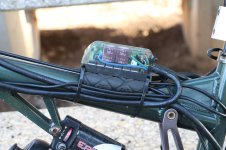
The Phaserunners worth every $ of the 295$ I spent on each of them. They (finally) let you do throttle->torque mapping, just like a normal motorcycle. They allow you to limit the phase-current, which solves ALL of the overheating issues, and since you limit the phase-current (and therefore the torque), and combined with the sine-wave - the gears of the ezee would live happily for many years. The ezee motor makes barely any audible noise! It's amazing.
Of course - 2 phaserunners also weight around the same weight of one Grinfineon 72V40A. Yes, the Grinfineon can take alot more abuse with it's 12FETs, but that "extra" power will mostly be converted to heat on the 2706, as I witnessed.
Two motors share perfectly the load together!
I set the 2706 to 55A phase current limit, and the ezee to 45A. No more high temps, smooth accelerations even from standstill at 13%+ grade, and addictive 2WD traction.
Now let's talk about the batteries.
During the testing, I used 4 A123 packs - each with 26650 cells at 12S1P configuration - 39.6V 2.3Ah for each.
All four were connected together to a pack either at 39.6V 9.2Ah configuration or 79.2V 4.6Ah.
Range was very short, but it taught me alot of things:
1. The Grinfineon is best if used at the 39.6V setting. The higher 79.2V was mapping a much bigger speed range with the same throttle twist, making the torque control very unpleasant and jumpy.
2. 79.2V allowed me to reach speeds on the flat of around 70Km/h (using only the 2706 while the ezee was freewheeling), while on uphills both motors worked together and achieved climbing speeds of 50-60Km/h - at 10% grades! (With the two phaserunners)
3. The Phaserunner doesn't care a shit about speed, only on torque - As long as you have enough battery voltage to overcome the back EMF. This means that the throttle control feels the same with either 39.6V or 79.2V. The only difference is that the 39.6V would limit your top speed much sooner. For more speed I could have enabled the field weakening, but I find it better to just have battery voltage which equals the highest (ever) speed I might need. (For example to merge with busy traffic). I tried the field weakening and it works just as promised - so you know in case you need it.
For the final battery pack I had a lot of dilemas: Voltage, Capacity, chemistry, and where to buy from. I was very close to buy NCA pack from em3ev, but eventually I bought a bunch of used A123 prismatic cells - 20Ah each. Since each cell is almost 500grams, I couldn't get to the high voltage I wanted - and settled on 17S - 56.1V with 20Ah capacity. That was the maximum voltage I could have charged with my 48V8A Satiator. (It goes up to 63V)
The pack weights 9Kg all together, which is only 0.5Kg over the weight of the packs themselves. Thanks to that I could stay very close to the 133Wh/Kg density of each of those cells, which is not very far from AllCells which have a much lower cycle-life and higher voltage sag.
Here are several pictures:

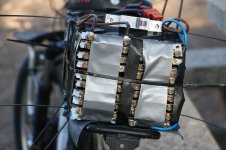
View attachment 6
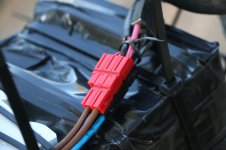
I used the original modular plastics that connects the cells together, but since they force to have a spacing material I improvised and used only half a plastic line at a time - so I can keep the cells touching each other. (That was the biggest weight saver).
There is no BMS, yet, and I dunno if I am going to get one. I plan to just charge to 3.5V/cell. You are allowed to 3.6V/cell, but the amount of additional energy going in by 3.5->3.6 is so negligible, it just doesn't worth the risk. I programmed the Phaserunners to LVC of 2.5V/cell but they start to ramp it down at 2.7V. The upper limit for regen was programmed at 3.5V/cell.
What do you think?
You can also see in one of the pictures how I used a 40A circuit breaker both as protection and to take the initial sparks at powerup. There are two parallel wires of similar gauge coming from the battery (for each controller), and each is terminated at it's own Anderson terminal. Since I draw around a max of 50A-60A - that should be around 25A-30A for each Anderson to bear.
All 4 Andersons are modulated together - so I can connect/disconnect both controllers at once.
I wanted the battery to be quick-released for charging scenarios where I can't get the bike close to the outlet.
And here is the battery rack:
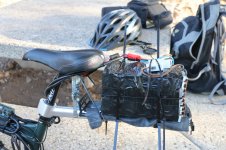

I used a seatpost rack rated at 15Kg. I will take it as 10Kg as a more realistic value, but since I am using a full suspension bike and the battery weight is sprung, I was less worried.
I fortified the rack as you can see with hose-clamp, transferring some of the load to the saddle, and an extra plastic cable tie - just for the sake of good luck.
What do you think?
While riding on bumpy roads today - I felt the suspension was doing it's job very well - as no shocks were transferred to the frame.
Using that kind of rack, allows me to use the quick release mechanism of the seat tube to take the battery with me.
And last - throttles.
I use two of them - right one for the front 2706, and left for the rear ezee.
I was thinking about fusing them into just one, controlling both motors - but it's just not realistic. There are situations I just want to use the direct drive 2706:
1. Slow cruising on flats at walking speed, or very high speeds on flats. (the ezee would be an energy waster here).
2. Regen braking - I twist the throttle for the proportional regen. The ezee doesn't need to be involved, although that can just make it stop as well. (and do nothing as it's freewheeling).
3. Stairs climbing - I dial a 250W power limit on the CA powering the front 2706, and it's just pulling the bike upstairs. No need for me to carry that weight! A direct-drive + phaserunner with it's accurate torque selection is perfect for that - The grinfineon was trying to kill the 2706 when doing the same..
Here are pictures of the throttles and the dual CA's. Each motor has it's own CA display.
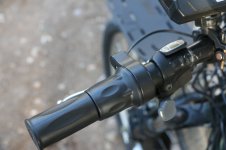
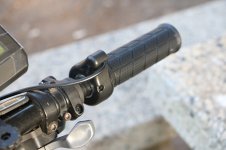
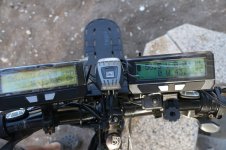
To conclude - I chose one geared motor and one direct drive to enjoy both worlds. That ezee motor is so impressive with it's torque output (taking WAY less power the 2706 would have needed to output the same torque) it's just an amazing piece of technology!
The ezee is dialled with it's left throttle to do most of the work on uphills while the 2706 is supporting it (I use the potentiometer to limit it's output power on that scenario). On flat-cruising and downhills - the 2706 do solely all the work.
That is all folks. What do you think?
After all my questions here during the recent months, I am happy to show you my built E-bike.
The bicycle is a Mongoose otero elite full suspension MTB, with 26inch wheels.
I bought it used specially for this project, because nowadays 26inch MTB's are very cheap.
It has 24gears, the rear shock absorber is SR Suntour "Epicon" which is air inflated (200PSI max), and the front is a simple elastomer SR Suntour:

There are two motors.
Front 9C+ 2706:

You can see how I used the disc-brake boss for a snug fit of the torque arm in the following close up image:

Although the bike originally came with hydraulic disc brakes, I changed the front one to V-brake for two reasons:
1. The 2706 has compatibility issues with discs
2. I couldn't find E-brake lever for hydraulic brakes...
The rear motor is the new cassette version of the 250rpm ezee, called ezee250rc on Grin website:

That modern motor fits the disc rotor perfectly as it was just a standard hub. The 8 speed cassette has been transferred as well - It's so nice to have the modern cassette-freewheel, instead of the older threads.
One downside (but also a plus-side), is that the ezee comes with a high quality cassette-freewheel, and since it has like 100 pawls it makes a much stronger buzz than the cheaper freewheels.
I used a front torque arm for the ezee, as you can see in the pic:

Why?
The V4 rear one couldn't be made to fit, since the frame has pivoting points very close to the dropout.
I mounted the torque arm, and using a hose-clamp applied a moderate forward torque which preloads it against the axle in the correct direction - The ezee only applies negative torque on the dropout since it has no regen. (yet... :wink: )
At the beginning of the project, I only had the front 2706 motor, powered by Grinfineon 72V40A. I didn't like the lack of traction, the fact the motor was overheating very quickly on the insane uphills we got here, and the throttle->speed mapping of the regular trapezoid controller made me nuts with it's lack of sensitivity. So I switched to the Phaserunner.
I bought two of them - for the front 2706 and for the rear ezee:


The Phaserunners worth every $ of the 295$ I spent on each of them. They (finally) let you do throttle->torque mapping, just like a normal motorcycle. They allow you to limit the phase-current, which solves ALL of the overheating issues, and since you limit the phase-current (and therefore the torque), and combined with the sine-wave - the gears of the ezee would live happily for many years. The ezee motor makes barely any audible noise! It's amazing.
Of course - 2 phaserunners also weight around the same weight of one Grinfineon 72V40A. Yes, the Grinfineon can take alot more abuse with it's 12FETs, but that "extra" power will mostly be converted to heat on the 2706, as I witnessed.
Two motors share perfectly the load together!
I set the 2706 to 55A phase current limit, and the ezee to 45A. No more high temps, smooth accelerations even from standstill at 13%+ grade, and addictive 2WD traction.
Now let's talk about the batteries.
During the testing, I used 4 A123 packs - each with 26650 cells at 12S1P configuration - 39.6V 2.3Ah for each.
All four were connected together to a pack either at 39.6V 9.2Ah configuration or 79.2V 4.6Ah.
Range was very short, but it taught me alot of things:
1. The Grinfineon is best if used at the 39.6V setting. The higher 79.2V was mapping a much bigger speed range with the same throttle twist, making the torque control very unpleasant and jumpy.
2. 79.2V allowed me to reach speeds on the flat of around 70Km/h (using only the 2706 while the ezee was freewheeling), while on uphills both motors worked together and achieved climbing speeds of 50-60Km/h - at 10% grades! (With the two phaserunners)
3. The Phaserunner doesn't care a shit about speed, only on torque - As long as you have enough battery voltage to overcome the back EMF. This means that the throttle control feels the same with either 39.6V or 79.2V. The only difference is that the 39.6V would limit your top speed much sooner. For more speed I could have enabled the field weakening, but I find it better to just have battery voltage which equals the highest (ever) speed I might need. (For example to merge with busy traffic). I tried the field weakening and it works just as promised - so you know in case you need it.
For the final battery pack I had a lot of dilemas: Voltage, Capacity, chemistry, and where to buy from. I was very close to buy NCA pack from em3ev, but eventually I bought a bunch of used A123 prismatic cells - 20Ah each. Since each cell is almost 500grams, I couldn't get to the high voltage I wanted - and settled on 17S - 56.1V with 20Ah capacity. That was the maximum voltage I could have charged with my 48V8A Satiator. (It goes up to 63V)
The pack weights 9Kg all together, which is only 0.5Kg over the weight of the packs themselves. Thanks to that I could stay very close to the 133Wh/Kg density of each of those cells, which is not very far from AllCells which have a much lower cycle-life and higher voltage sag.
Here are several pictures:


View attachment 6

I used the original modular plastics that connects the cells together, but since they force to have a spacing material I improvised and used only half a plastic line at a time - so I can keep the cells touching each other. (That was the biggest weight saver).
There is no BMS, yet, and I dunno if I am going to get one. I plan to just charge to 3.5V/cell. You are allowed to 3.6V/cell, but the amount of additional energy going in by 3.5->3.6 is so negligible, it just doesn't worth the risk. I programmed the Phaserunners to LVC of 2.5V/cell but they start to ramp it down at 2.7V. The upper limit for regen was programmed at 3.5V/cell.
What do you think?
You can also see in one of the pictures how I used a 40A circuit breaker both as protection and to take the initial sparks at powerup. There are two parallel wires of similar gauge coming from the battery (for each controller), and each is terminated at it's own Anderson terminal. Since I draw around a max of 50A-60A - that should be around 25A-30A for each Anderson to bear.
All 4 Andersons are modulated together - so I can connect/disconnect both controllers at once.
I wanted the battery to be quick-released for charging scenarios where I can't get the bike close to the outlet.
And here is the battery rack:


I used a seatpost rack rated at 15Kg. I will take it as 10Kg as a more realistic value, but since I am using a full suspension bike and the battery weight is sprung, I was less worried.
I fortified the rack as you can see with hose-clamp, transferring some of the load to the saddle, and an extra plastic cable tie - just for the sake of good luck.
What do you think?
While riding on bumpy roads today - I felt the suspension was doing it's job very well - as no shocks were transferred to the frame.
Using that kind of rack, allows me to use the quick release mechanism of the seat tube to take the battery with me.
And last - throttles.
I use two of them - right one for the front 2706, and left for the rear ezee.
I was thinking about fusing them into just one, controlling both motors - but it's just not realistic. There are situations I just want to use the direct drive 2706:
1. Slow cruising on flats at walking speed, or very high speeds on flats. (the ezee would be an energy waster here).
2. Regen braking - I twist the throttle for the proportional regen. The ezee doesn't need to be involved, although that can just make it stop as well. (and do nothing as it's freewheeling).
3. Stairs climbing - I dial a 250W power limit on the CA powering the front 2706, and it's just pulling the bike upstairs. No need for me to carry that weight! A direct-drive + phaserunner with it's accurate torque selection is perfect for that - The grinfineon was trying to kill the 2706 when doing the same..
Here are pictures of the throttles and the dual CA's. Each motor has it's own CA display.



To conclude - I chose one geared motor and one direct drive to enjoy both worlds. That ezee motor is so impressive with it's torque output (taking WAY less power the 2706 would have needed to output the same torque) it's just an amazing piece of technology!
The ezee is dialled with it's left throttle to do most of the work on uphills while the 2706 is supporting it (I use the potentiometer to limit it's output power on that scenario). On flat-cruising and downhills - the 2706 do solely all the work.
That is all folks. What do you think?


